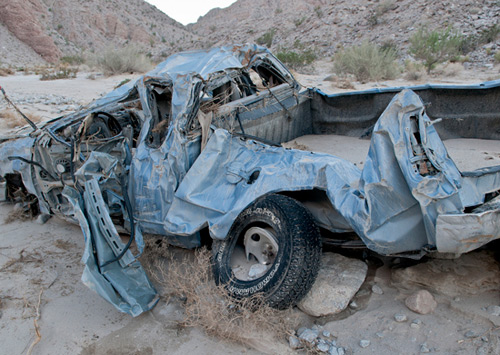
The Desert Monsoon Season and flash floods
Although desert flash floods can occur at any time of year the most common
time in
Anza-Borrego is during the late summer monsoon season (July - August -
September). During the monsoon season the airflow changes from west to east
to south to north and large masses of warm and very moist air come into the
deserts of Arizona and Southern California from Mexico. As each day
gets started and the strong summer sun warms the ground, this moist air is
heated and it rises higher into the atmosphere, where clouds form as the
water condenses.
Powerful thunderstorms are then created that can drop
large amounts of rain in a very short period of time, sometimes at a rate of several
inches per hour. The soil is unable to absorb the water at the rate it is
falling so a widespread surface flow quickly develops across the land. The
surface flow may only be a fraction of an inch deep but across thousands of
acres or many square miles, an enormous amount of water can rapidly be on
the move. All of this water heads for the lowest ground, and the
water continues to consolidate as it finds the path of least resistance
headed downhill. This does not need to be in steep terrain. An
area that may appear relatively flat can quickly accumulate a tremendous
flow of water across an incline that may scarcely be visible. The
water may spread out for miles or, in places where it is confined to narrow
canyons or dips in roadways, it can turn a dry area into a violent river of
water capable of carrying trees and cars in as little as ten or fifteen
minutes.
The most significant floods occur when these thunderstorm systems become
stationary. A vertical "conveyer belt" effect is created in which hot
air rises into the sky, cools and condenses, and drops heavy rain. The
air is reheated at ground level and then drawn up again and again to repeat
the cycle. The result is a powerful stationary weather system that
becomes a very localized and relentless rain-making machine. The
record rate of rainfall in California during a one hour period is 10.1
inches, recorded in Campo, just a few miles north of the Mexican border in
San Diego County, during one such event. in 2013 the city of Mecca, Ca
experienced over five inches of rain in a twenty minute period from one of
these storms.
It has been said that the two most common ways for people to die in the
desert are from thirst and by drowning.
The lack of vegetative cover in the desert allows the water to gather momentum
and the washes or canyons where it accumulates can become raging torrents in a
very short period of time. The land does not need to be steep for flash floods
to occur, large gently sloping areas can also accumulate large amounts of water.
Desert flash floods can quickly cut through the earth, dislodging sand,
rocks, boulders, and trees, and then deposit them many miles from their
source.
Flash floods are particularly dangerous because it is very difficult to predict
exactly when and where they may take place. Forecasters may only know the
general area where flashloods are likely, such as "The desert areas of
southern Calfornia" but they cannot pinpoint where in that vast area that
the localized weather systems to create the floods will be formed.
 |